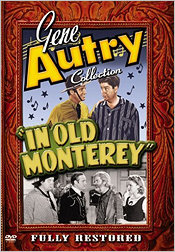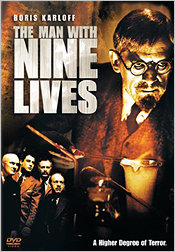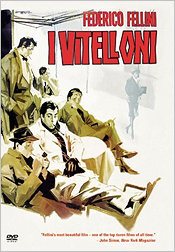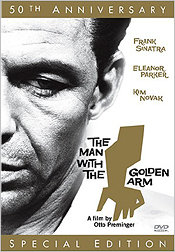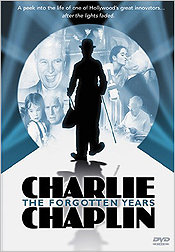 |
Site created 12/15/97.

page created: 11/3/05
 Barrie Maxwell - Main Page |
| Classic
Reviews Roundup #23 - November 2005, and New Announcements This collection of reviews focuses on twelve recent offerings from independent releasers Image Entertainment and Hart Sharp Video. One major studio title from Sony (Columbia) is thrown in for good measure though. The reviews are ordered by the year of original theatrical or television release. I also have new classic announcements for you following the reviews section. The Classic Release Database has been updated accordingly. |
| The
film is interesting from several points of view. Republic, one of
the minor studios, was obviously making a statement in favour of
U.S. preparedness for war despite much isolationist sentiment in the
country. Among the major studios, only Warner Bros. was being
noticeably overt about its support. The story itself leaves one with
ambivalent feelings. Even though the script has the townspeople
eventually see the error of their ways, one can't help feel that
they have been harshly treated by their own government. After all,
it's hard to believe that the Army can't find a chunk of vacant land
to train on rather than expropriate a whole town and disrupt
numerous people's lives. As an Autry western, the film contains the
usual songs and some modest action sequences, including several that
feature a mini tank. The film's title was obviously only chosen
because Gene sings a song with that title. Otherwise, the film has
nothing whatsoever to do with Monterey or Mexico at all for that
matter. Gabby Hayes has a welcome role as a leading townsperson, and
easily outshines Smiley Burnette in providing comic relief. The film is another in Image's continuing release of the Autry westerns. They've been restored under the auspices of the Autry National Center in Los Angeles and the Encore Westerns Channel. The full frame DVD transfer is quite decent. Black levels are fine while contrast and image detail look very good for the most part. Modest speckling and the odd scratch are in evidence. The mono sound is relatively clear and free of distortion, but no sub-titling is provided. The disc has the usual fine package of supplements including excerpts from the Melody Ranch Theater of the 1980s in which Gene Autry and Pat Buttram reminisce about the film. Other items include filmographies, production and publicity stills, poster and lobby card art, and original press kit material. This is one of the more offbeat Autry westerns and well worth a rental. |
| Columbia
does try to give the whole thing some atmosphere with shadowy
laboratory sequences and a rather effective scene of Dr. Mason
breaking his way through thick ice to un-entomb Kravaal, but the
overall effect falls far short of many of Karloff's earlier
Universal films in that respect. The freezing technique consists of
ice cubes to cool bodies down and while that may seem pretty
simplistic even for a B-grade picture, the idea of hot coffee as the
scientific method to warm bodies up is rather farcical. Sony's full screen presentation is correctly framed and for the most part looks quite attractive. There are speckles and occasional scratches, but the image is quite bright and crisp with mild grain in evidence (although the latter results in a couple of murky dark scenes). During the film's last 10 or 15 minutes, image quality is reduced in sharpness with some brightness fluctuations in evidence suggesting that later generation material may have had to be used as the source for that portion. The mono sound is clear but unremarkable. English, French, and Japanese sub-titles are provided. The supplements consist of trailers for several recent horror films, all of which make The Man with Nine Lives, for all its shortcomings, look almost like a masterpiece in comparison. |
| Fellini
tries to leaven his portrait with flashes of humour, but it never
really dispels the aura of a dead-end life that virtually all these
young men seem destined for. Ironically Fausto, the one we have
least sympathy for, looks as though he may find undeserved happiness
in the end while Moraldo, the most sympathetic character, seems
destined for unfulfilment despite his brave (at least for this
bunch) act at the end. Strange then that of all the characters,
Moraldo was the one most like Fellini himself. The film initially was difficult to sell as it apparently was considered too downbeat and out-of-step with the then-current Italian cinema which had already pretty well finished with the neorealism of Rossellini and De Sica. After winning a Silver Lion at Venice in 1953, however, a distribution deal was struck. I Vitelloni has since been recognized as one of Fellini's major achievements and an inspiration for other filmmakers. Certainly it's an engrossing portrait of a slice of society and one that retains its interest some 50 years later, not only for its own sake but also for its use of settings and symbolism that would eventually characterize so much of Fellini's later work. Image's presentation, by arrangement with Corinth Films, is quite decent. The full frame image is bright with fairly deep blacks and reasonable image detail. Some scenes are a little dark and there is some jitter in evidence, but some apparent source material damage is in intrusive. The Italian mono sound seems clear enough with but minor hiss. Optional English subtitles are provided and they convey the story quite adequately. The only supplement is a photo gallery of some 30-odd stills. There is of course already a Criterion DVD release of I Vitelloni and it remains the best version to get, but strictly on price alone for the basic film this Image release is recommended. |
| Viewed
50 years later, the film retains its power despite the many films
that have since dealt with the same subject. In this instance, it is
the story of recovered drug addict Frankie Machine (Frank Sinatra)
who returns to his old neighborhood with dreams of becoming a
drummer as a result of training he received while in rehab.
Unfortunately, circumstances soon draw him into his old crowd of
gamblers and drug dealers (personified in a character played by
Darren McGavin), and to his previous job as an ace card dealer, with
the inevitable pressures of such a life. Complicating things are
Frankie's wife (Eleanor Parker) who has been crippled as the result
of a car accident for which Frankie was responsible and a former
girlfriend (Kim Novak). The film is a tour-de-force for Sinatra who
creates a mesmerizing portrait of Frankie including a short but
reasonably convincing portrait of a man going through withdrawal,
but the supporting cast is also uniformly excellent. McGavin is
particularly impressive as the oily drug pusher. Preminger creates a
realistic aura of decay and low-life futility, managing to transcend
virtually completely the studio-bound production. There had been
intentions to film on location in Chicago, but the cost was
prohibitive given the budget. The Laureate Company released a single DVD version of the film in the U.K. in 2003 and in association with Artanis Entertainment Group (Sinatra Enterprises) has developed a new two-disc remastered and expanded edition. This version has been designated a 50th Anniversary Special Edition and has been released in Region 1 by Hart Sharp Video. The results are impressive and improve very substantially on any of the other DVD releases that exist for this public domain film. Utilizing a master derived from three different 35mm prints, the correctly-framed full screen image looks sharp aside from a few soft-looking spots and offers a nice-looking gray-scale range. Shadow detail is very good and edge effects are not an issue. There are a number of stray speckles and the odd scratch or bit of debris, but they're never intrusive. The fact that this is a PAL-originated NTSC DVD does not generate to any intrusive degree the types of transfer issues that can result from such a presentation. Both the original mono (some slight background hiss) and a new Dolby Digital 5.1 track are offered. The latter is a solid effort that does add some depth and very modest front directionality to Elmer Bernstein's impressive jazz score. English, French, and Spanish subtitles are provided. The release has two particularly fine supplements - an entertaining and very informative audio commentary by film historian Ken Barnes and a 42-minute filmed conversation between Barnes and Elmer Bernstein that delves into details of the music for this film as well as for the rest of Bernstein's career. Other supplements such as a brief video excerpt concerning Sinatra's preparation for his role taken from a 1990 interview with Sinatra and a montage of scenes from the film cut to Sinatra singing the film's title song (incidentally not used in the film itself) are presented courtesy of Artanis Entertainment's involvement in the disc. The release is rounded out with the original theatrical trailer, production background notes, and cast and crew bios. An unexpectedly fine, and very welcome release of a superior film. Highly recommended. The Twilight Zone: The Definitive Edition - Season 3 (1961-1962) (released on DVD by Image on June 28th, 2005) The Twilight Zone: The Definitive Edition - Season 4 (1963) (released on DVD by Image on October 18th, 2005) The original Twilight Zone television series lasted for five seasons on CBS during the period 1959-1964. Hosted and mainly written by Rod Serling, it was a show of ideas and altered realities ranging from the occult to science fiction to fantasy, in stark contrast to the western, detective, and comedy series that tended to dominate primetime television at that time. Over the intervening years, Twilight Zone has retained the imagination of old viewers and excited that of new ones, sparking new Twilight Zone series and a feature film. None of these have managed to match the excellence of the original, however. The original series has had numerous video incarnations, but the best one is Image's current series of full season box sets that originates from high definition transfers utilizing the original camera negatives and magnetic soundtracks. Seasons 3 and 4 have been released during the past four months and the fifth and final season is slated for a late December appearance. |
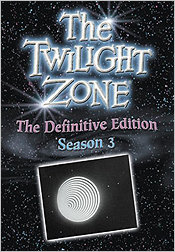 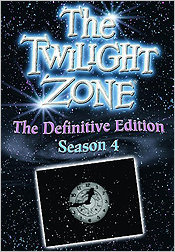 |
| Season
3 comprised a total of 37 half-hour episodes with the first one
airing on September 15th, 1961 and the final one on June 1st, 1962.
It and the first two seasons are generally considered to contain the
bulk of the series' many fine episodes. Highlights from Season 3
include: Two, The
Grave, Nothing in the Dark,
It's a Good Life, Deaths-Head
Revisited, To Serve Man,
A Game of Pool, Kick
the Can, Little Girl Lost,
The Dummy, The
Changing of the Guard, and The
Trade-Ins. Appearing are the likes of Lee Marvin, Robert
Redford, Charles Bronson, Joseph Schildkraut, Elizabeth Montgomery,
Gladys Cooper, Cloris Leachman, Lloyd Bochner, Gary Merrill, Dean
Stockwell, Jack Klugman, Jonathan Winters, Peter Falk, Buster
Keaton, Barry Morse, Cliff Robertson, Carol Burnett, and Donald
Pleasence. That's a pretty fine pedigree for any series, but merely
typical of what Twilight Zone
offered throughout its run. Twilight Zone was slow in lining up a sponsor for its fourth season and it did not appear on CBS's fall schedule for the 1962-1963 season. Eventually the difficulties were resolved and the series was renewed. Its return, however, would be in a one-hour format and would be delayed until January 1963. Consequently, Season 4 comprised only 18 episodes with the first one airing on January 3rd, 1963 and the final one on May 23rd, 1963. Probably unlike many fans, I have a particular fondness for the one-hour episodes mainly because they were the first Twilight Zone programs I can remember watching regularly. Even now, although I appreciate the craft of many of the earlier half-hour programs, the extra time allowed the fourth season shows to have generally better character development, as one might anticipate. In reviewing this DVD release, I was particularly delighted to revisit Valley of the Shadow (Ed Nelson finds himself trapped in a small town where the townsfolk can perform amazing feats), He's Alive (Dennis Hopper as a neo-Nazi leader craving power and attention gets help from an unexpected source), Death Ship (Jack Klugman and his crew discover a wrecked duplicate of their spaceship and their dead bodies), Printer's Devil (Burgess Meredith offers the devil of a deal to save a failing newspaper), The Parallel (astronaut Steve Forrest returns to the Earth he knew, or does he), and The Bard (would-be TV writer Jack Weston gets help from the ghost of William Shakespeare). As with its box sets for Seasons 1 and 2, Image has again delivered (as the titles state) the definitive editions of Seasons 3 (a five-disc set) and 4 (a six-disc set). The full-frame transfers are without exception amazingly good - crisp, well-contrasted, and characterized by great image detail. There are of course a few speckles and the odd bit of debris, but that's insignificant in comparison to the pleasure of seeing the programs look better than they ever have. The mono sound is also in fine shape with all dialogue sounding very clear. There is some mild background hiss in evidence, somewhat more so on the fourth season episodes, but it's never an issue in enjoying the programs. English captions for the hearing-impaired are provided. An impressive collection of supplementary information is offered in each set. Every episode offers at least one supplementary item, ranging from isolated scores to audio commentaries, interviews with particular cast or crew members, complementary Twilight Zone radio dramas, or clips from episodes remade as part of later Twilight Zone series. Additional bonus materials are included on the final discs of each set. For Season 3, these include various promo spots for SciFi Channel Twilight Zone marathons and for Rod Serling's later series Night Gallery, a photo gallery and various sponsor billboards, a promo for the Famous Writers School in which Serling was involved. For Season 4, there is a "Twilite Zone" skit from Saturday Night Live, a Genesee beer spot featuring Rod Serling, as well as more photos, promos, and advertising billboards. Both sets also offer DVD-ROM access to The Twilight Zone 34-page comic book. Both sets are recommended, as incidentally are the sets for Seasons 1 and 2. The Season 1 box is particularly attractive as it includes a hard copy of the second edition of the series' bible - the 466-page "The Twilight Zone Companion" by Marc Scott Zicree. Combat!: Season 3, Operations 1 and 2 (1964-1965) (both released on DVD by Image on March 29th, 2005) Combat!: Season 4, Conflicts 1 and 2 (1965-1966) (both released on DVD by Image on May 24th, 2005) Combat!: Season 5, Invasions 1 and 2 (1966-1967) (both released on DVD by Image on August 30th, 2005) Combat! was one of two World War II drama series that debuted on network television in the 1962-1963 season. The other was The Gallant Men, which lasted only one season. Combat!, however, would go on for a total of five seasons and over 150 episodes and establish Sergeant Saunders as portrayed by Vic Morrow as one of the enduring characters remembered fondly from primetime television of well over a generation ago. |
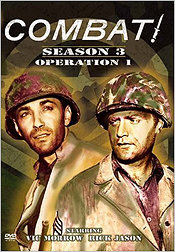 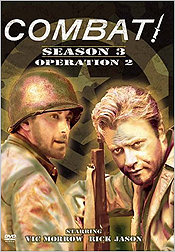 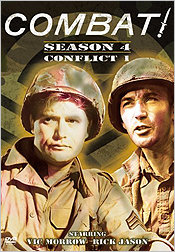 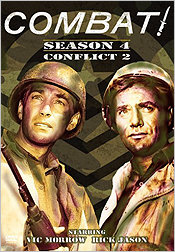  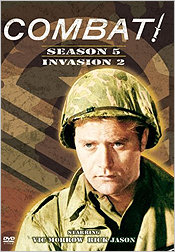 |
| I
remember Combat! as being a
must-view when it first aired and it's a pleasure to revisit the
show four decades later and find that it still holds up very well.
The excellence of the ensemble cast that made the show so appealing
originally has stood it in good stead over the years. Aside from Vic
Morrow and the other star Rick Jason (Lt. Hanley, whom I nearly
always found less interesting), veteran Combat!
watchers will remember with fondness the likes of Pierre Jalbert
(Caje), Jack Hogan (Kirby), Dick Peabody (Littlejohn), and Conlan
Carter (Doc). Of the latter four, I believe only Jalbert appeared in
all five years of the show. Supplementing the regulars was a
continuous stream of guest stars including the likes of Jeffrey
Hunter, Howard Duff, Gary Merrill, Robert Culp, Lee Marvin, James
Coburn, James Caan, Beau Bridges, Robert Duvall, Charles Bronson,
James Whitmore, Roddy McDowall, Telly Savalas, Mickey Rooney, Jack
Lord, Sal Mineo, Leonard Nimoy, Claude Akins, and Warren Stevens - a
pretty fine lineup by any standard. Aside from the cast, the show's
assets included fine direction that made good use of the MGM backlot
as well as some inspired location work at times (particularly in the
show's fifth year). Robert Altman directed many of the first
season's episodes, while Michael Caffey did many of the later ones.
Vic Morrow also took the directing reins at times and produced many
top-notch efforts. Combat! appeared on the ABC television network and followed the progress of an American army squad in Europe after D-Day. Although that part of the actual war lasted less than a year, the Combat! regulars slugged their way through France for five years and never got out of that country. The first season followed the war's actual events chronologically, but thereafter little attention was paid to an accurate timeline. The show's third season was the one in which it scored most highly in the ratings overall although individual episodes had always done well. Episodes were filmed in black and white, switching to colour only for the show's final season. Much more detail on production and individual episodes may be found at the excellent Combat! fan site. For Season Three, some of the best episodes are The Long Walk, The Duel, Point of View, The Hard Way Back, The Little Carousel, The Enemy, The Steeple, and Cry in the Ruins. Season Four contains one of the series' highlights, the two-part Hills Are for Heroes directed by Vic Morrow. Other fine episodes are Finest Hour (with Luise Rainer and Ramon Navarro!), The Raider, Retribution, The First Day, Nothing to Lose, and The Leader. Season Five highlights include The Gun, The Chapel at Able Five, Headcount, Conflict, and Entombed (with Margaret O'Brien). Image is generally doing a fine job with its television show discs. Its presentations of The Dick Van Dyke Show, Twilight Zone, and now Combat! on DVD show some real care about the material although Image is at the mercy of the companies providing the source material. In the case of Combat!, that's Disney. The earlier season discs have had some image and time compression issues, but the three seasons reviewed here don't really exhibit much to complain about image-wise. The time compression issue still exists for Seasons Three and Four, but not for Season Five. The Combat! shows, packaged in half seasons with four discs per box, are presented full frame as originally broadcast and image quality is quite satisfactory. Results are for the most part crisp and clear with few defects other than some minor speckling. Contrast and shadow detail is good-to-very good on the Season Three and Four discs while colour fidelity for Season Five is also very good, although some image softness intrudes at times. The mono sound does the job quite adequately on all discs. There is no subtitling provided. The supplementary material is good. Notes, oddities, and bloopers for each episode are provided by Combat! expert Jo Davidsmeyer while audio commentaries (by an actor or director) for two or three episodes are included on each set. The Season Five sets include an informative documentary Combat!: This Season in Color featuring interviews with the likes of Michael Caffey, Pierre Jalbert, and Conlan Carter (Vic Morrow and Rick Jason are no longer with us). Despite the disappointing time compression issues for Seasons Three and Four, which seem unlikely to be corrected since another Combat! release wouldn't appear to be in the cards, all these Combat! sets are recommended. Note that Combat!: The Complete Series (that's all ten sets of 4 discs each) will be issued by Image on December 6th. |
| In
2003, a Swiss production was made that focused on those years of
Chaplin's life in Europe. Charlie
Chaplin: The Forgotten Years provides an interesting and
sometimes revealing portrait of a man who continued to devote his
time to the film-making and writing he loved, even if the results no
longer held the same interest for the world at large. The production
relies heavily on the reminiscences of three of Chaplin's children
(Michael, Eugene, and Geraldine Chaplin) as well as a generous
amount of Chaplin home movie footage. This material is well edited
together and supplemented with further comments from Chaplin
colleagues such as Peter Ustinov and Petula Clark as well as other
family acquaintances. The profile runs about 55 minutes and although
it seems to suggest a life of continuing vitality for those last 25
years of Chaplin's life, one senses it to have been also an
existence that was strongly family-oriented (though not particularly
smooth-sailing for Chaplin's children) and generally low key in
public profile. Hart Sharp Video has released this documentary on DVD with a full frame transfer, which seems correctly framed and presumably reflects how it was originally produced. The portions of the image that constitute newly-shot footage are quite crisp with good colour fidelity. The archival material varies in quality, depending on the condition of the source material, but is for the most part quite acceptable. The stereo sound is adequate for the dialogue-intensive track. English subtitles are provided. Supplements consist of about 20 minutes of additional interview footage with Chaplin's children and a small poster gallery of Chaplin's films. Chaplin aficionados will probably want to have this release, but for most others, a rental will be quite adequate. The Latest Classic Release Announcements Let's go in reverse alphabetical order this time. The Classic Release Database has been updated accordingly. Warner Bros. will release its annual Oscar-related slate on January 31st. Two are former Best Picture winners - 1931's Cimarron and 1939's Gone with the Wind. The latter is a two-disc version, presumably last year's four-disc release shorn of its two discs of supplementary features. Cimarron will include the 1931 MGM short The Devil's Cabaret and the 1931 WB cartoon Red Headed Baby. The other six releases mainly celebrate previous Best Actor and Best Actress awards - The Champ (1930, Wallace Beery), Captains Courageous (1937, Spencer Tracy), The Good Earth (1937, Luise Rainer), Kitty Foyle (1940, Ginger Rogers), Johnny Belinda (1948, Jane Wyman), and Lust for Life (Anthony Quinn - Best Supporting Actor). The disc for The Champ will include the 1930 MGM short Crazy House. Captains Courageous will include the 1937 MGM short The Little Maestro and the 1937 MGM cartoon Little Buck Cheeser. The Good Earth will include the 1937 MGM short Hollywood Party. Kitty Foyle will include the 1948 Tom and Jerry cartoon Kitty Foiled and the 1949 MGM cartoon Bad Luck Blackie. Johnny Belinda will include the 1948 WB short The Little Archer. Lust for Life will offer audio commentary by Drew Casper. All these releases will be full frame as originally shown except for Lust for Life which will sport a 2.40:1 anamorphic transfer. On February 7th, Warner finally brings David Lean's Ryan's Daughter (1970) to DVD in a two-disc Special Edition. It will offer a new digital transfer from the restored 65mm picture and a remastered soundtrack. Supplements include a three part 35th anniversary making-of documentary and audio commentary by cast, crew, biographers, current directors as well as Lean's and Robert Mitchum's families. VCI has moved its release of Blood and Black Lace, City of the Dead, and Gorgo from October 25th to November 8th. On November 22nd, they will release a Special Edition of The Fighting Sullivans (1944), one of the inspirations for Saving Private Ryan and previously only available as a Roan Group release (since OOP). Also coming then is Beyond All Limits (1959, with Jack Palance), the American release version of a Mexican film originally known as Flor de Mayo. In serial news, the two Johnny Mack Brown efforts, Flaming Frontiers (1938) and The Oregon Trail (1939), are now scheduled for December 6th. Also in VCI's serial plans for 2006 are Overland Mail (1942, with Lon Chaney, Jr.), Raiders of Ghost City (1944, with Dennis Moore and Lionel Atwill), Jungle Queen (1945, with Ruth Roman), Tim Tyler's Luck (1937, with Frankie Thomas), and a restored and remastered Special Edition of The Phantom Empire (1935, with Gene Autry). Sony's Columbia arm will release The Valachi Papers (1972, with Charles Bronson) on January 3rd as well as what appears to be a four-cartoon compilation entitled Cartoon Adventures: Gerald McBoing-Boing. The MGM arm will have Fox in a Box Featuring Pam Grier on December 6th. It will include three of Grier's films: Coffy (1973), Sheba, Baby (1975), and Foxy Brown (1974), as well as a fourth disc featuring comments by current hip-hop artists. MGM also has a new two-disc edition of The Producers (1968, with Zero Mostel and Gene Wilder) timed to appear with the new theatrical version. The DVD offering will appear on December 13th and will include a five part making of documentary (Act I, Act II, Closing, Intermission and Opening), Peter Sellers' Statement read by Paul Mazursky, a photo gallery, deleted scene (Playhouse Outtake), storyboard sketch gallery, and the film's theatrical trailer. Koch Lorber already released a very nice two-disc version of La Dolce Vita (1960, with Marcello Mastroianni), but appear to be trying to go back to the well for an extra dip with a three-disc Deluxe Collector's Edition set for a November 8th release. This new release just repeats the original's two discs and adds a third containing mainly interviews with various cast and crew members. As previously mentioned in these columns, Kino Films will release three of German director Arnold Fanck's "Mountain" films starring Leni Riefenstahl. Now set for a November 8th release are The White Hell of Pitz Palu (1929), Storm Over Mont Blanc (1930) and S.O.S. Iceberg (1933). Pitz Palu will include "The Immoderation in Me" hour-long 2002 interview with Riefenstahl, an excerpt of the 1935 sound re-issue version and a photo gallery. Mont Blanc will include the rare 1924 Fanck short Cloud Phenomena of Maloja, and a photo gallery. S.O.S. Iceberg will have the complete alternate English-language version (filmed simultaneously with actors Gordon Gowland and Rod La Rocque) and a photo gallery. Image will release the 1951 Lawrence Tierney film The Hoodlum on January 3rd. Further information on Fox's January 10th releases indicates that Island in the Sun will have audio commentary by John Stanley and the Dorothy Dandridge: Little Girl Lost documentary, Stormy Weather will have audio commentary by Dr. Todd Boyd and the Bill Robinson: Mr. Bojangles documentary, and Pinky will have audio commentary by Kenneth Geist. In other Fox news, the company is apparently preparing The Jayne Mansfield Collection (a box set including The Wayward Bus [1957], The Girl Can't Help It [1956], and Will Success Spoil Rock Hunter? [1957]), and new special editions of Valley of the Dolls (1967) and Beyond the Valley of the Dolls (1970) for release in early 2006. Various sources first in the fan community and now within the industry are lending credence to the likelihood that we will start to see Fox release its Charlie Chan films in 2006. As a further bonus, Mr. Moto may well be on the way too. This is still conjecture at this point, as I have been unable to get any industry confirmation on the record so far. My thanks to Tom Dubel for first alerting me to this situation, however. The scenario suggests that as part of a new "Cinema Classics Collection" line that Fox will introduce in 2006, the Fox Chan films will be released chronologically in sets of four with the first possibly scheduled to appear in March. Charlie Chan in London (1934) and Charlie Chan in Paris (1935) would appear to be certainties for the initial volume, but the others are less clear. A number of the early Chans are lost while Charlie Chan Carries On (1931) is only available as the Spanish language version Eran Trece. The Black Camel (1931) is now controlled by Warner Bros, I believe. Depending upon which if any of these is available to Fox, we may also get Charlie Chan in Shanghai in the first batch. Further volumes would follow in July and December. There are eight Mr. Moto films and these would potentially be released in two four-title volumes to appear in June and November of 2006. This is exciting information for all long-suffering Chan and Moto fans, but enthusiasm should be tempered until there is concrete confirmation. Dark Sky Films (a division of MPI) will have Dog Eat Dog (1964, with Jayne Mansfield on February 8th while The TV series The Invisible Man: Collection One (1958, 13 episodes) is being prepped for a first quarter 2006 release. Also in the plans is Jack the Ripper (1960, with Monte Berman). Criterion's plans for February include on La Bete Humaine (1938, directed by Jean Renoir) on the 14th, with Kind Hearts and Coronets (1949, with Alec Guinness) and Viridiana (1961, directed by Luis Bunuel) following on the 28th. Also in the works for early 2006 is Mr. Arkadin (1955, directed by Orson Welles, and likely a three-disc set). Anchor Bay now plans to release Take a Hard Ride (1975, with Lee Van Cleef) on January 17th (previously expected this fall). Alpha has 20 new releases set for December 27th. It's the usual mix of mainly westerns (Three Mesquiteers, Ken Maynard, Tim McCoy), mysteries, and TV show compilations (some GE Theater programs this time). There are two serial offerings - Flaming Frontiers (1938) and The Painted Stallion (1937). See the database for the complete list of titles. Well, once again that's it for now. See you all again soon. Barrie Maxwell barriemaxwell@thedigitalbits.com |
Barrie Maxwell - Main Page
 |
| Site
designed for 1024 x 768 resolution, using 16M colors and .gif 89a
animation. © 1997-2015 The Digital Bits, Inc., All Rights Reserved. billhunt@thedigitalbits.com |
